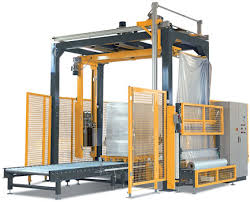Automatic Stretch Wrap Systems Saves Time and Money.
Unitizing equipment stretches to meet demand
Stretch wrap: Is it time for lean packaging?
Users of end-of-line packaging machinery need units that can
create high-quality, shipment-safe, secured loads of varying profiles at
increased production speeds. They’re also paying particular attention to
uptime, looking for equipment that requires minimal operator intervention to
operate, reload and maintain.
In this article, Modern takes a look at some of the latest
features in unitizing technology.
Stretch wrapper advancements improve load safety, quality
There’s been a big focus, directed particularly toward
manufacturers of consumer goods, on improving the quality of stretch wrapped
loads. “Billions of dollars of product waste occurs annually because loads are
damaged on the way from the manufacturer to the retailer”
Stretch film tightly unitizes a load because it continuously
attempts to contract back to its unstretched state. But, just because film is
pre-stretched and applied to a load doesn’t mean the load won’t fail in
shipment. Determining why loads fail, and how to stop them, is prompting
shippers to develop and adhere to wrapping standards that minimize the risk of
damage to product in transit.
“Just by consistently doing three things—ensuring the load
has the minimum amount of containment force, locking the load to the pallet,
and tucking the beginning and ending tails into the stretch film—shippers can
have a massive impact on damage reduction.
“We encourage customers to look at their stretch wrapper not
as the last machine at the end of the packaging line, but instead as the first
and most critical machine at the beginning of their shipping and logistics
process.
To help develop those wrap standards, suppliers of both
automated and semi-automated stretch wrappers increasingly offer sophisticated
test labs for load analysis. Lee’s company documents testing with high-speed
photography showing how wrapped loads behave on shaker tables and
acceleration/deceleration sleds.
“This helps determine the correct way to wrap specific
loads. Research has shown that to wrap loads correctly, to ensure that they
arrive at their final destination free from damage, that you must control film
placement, containment force and prestretch levels.
The latest machines are capable of delivering multi-level,
variable containment force as they wrap the film in a spiral up and down a
load. “Once the failure points in a load are identified, we can recommend the
type of film that should be used and the amount of containment force required;
the correct film placement and the optimal pre-stretch level for each load; as
well as set up multiple wrapping menus so a single machine can wrap multiple
types of loads.
To determine the appropriate wrapping program for a given
load, fully automated systems receive a signal from a palletizer, use a scanner
to read load information with bar code, or are equipped with a sensor to detect
load height or a scale to determine load weight. Alternately, semi-automated
machines with human machine interfaces (HMIs) share graphical displays for easy
wrap profile selection. Some even display the amount of containment force and
prestretch applied to each layer of film.
In addition to accommodating multiple types of loads with
multiple pre-programmed wrapping profiles, some of the latest stretch wrappers
have multiple film carriages. A four-carriage machine, for example, can
automatically switch between up to four different types of film.
“This feature allows one wrapper to service multiple
production lines; alternately, it can be set up with four rolls of the same
film for long, unattended production runs for labor and downtime savings. Film
can be reloaded from the back of the machine without stopping its operation,
keeping the operator completely out of an unsafe area.
That’s important for users who have recorded downtime as
long as 5 minutes for film roll changeovers by experienced operators. Because of all the integrated safety devices
they have to disable before entering the machine, and then reset after exiting.
Other ease-of-use enhancements include the engineering of
lower profile automated equipment with ramps that allow single, double or
triple walkie pallet jacks to load the stretch wrapper with any style of
pallet.




Comments
Post a Comment